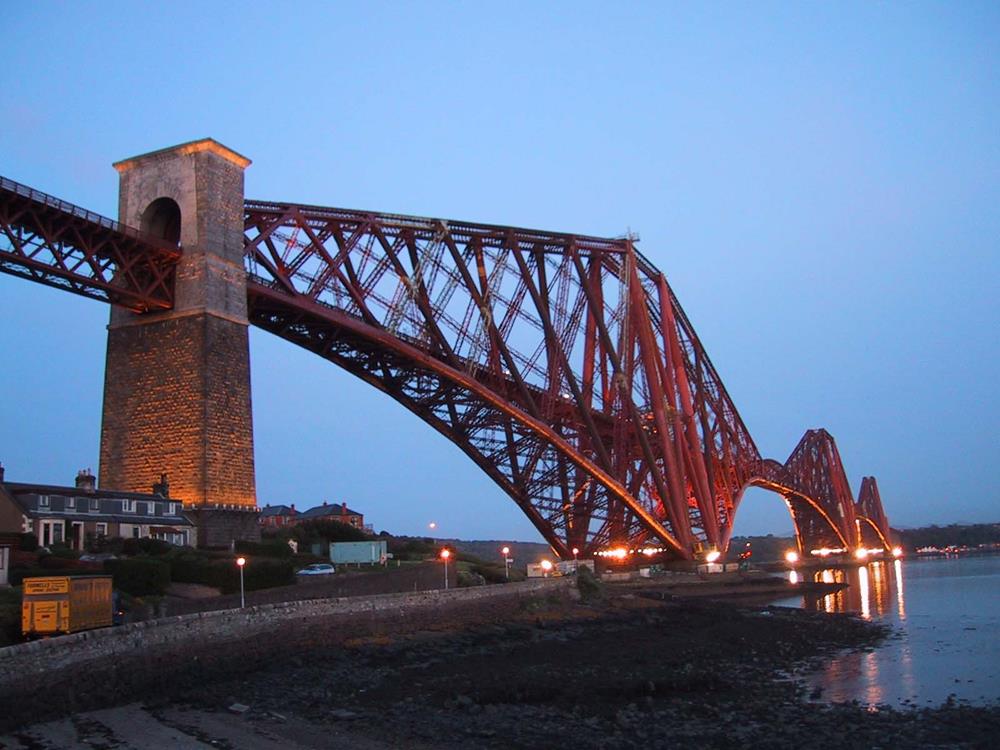The Queensferry Passage
Ferries
 The Woolwich
The Woolwich
Around 1070, Queen Margaret of Scotland bequeathed the income from a tract of land to provide free passage to pilgrims travelling North to Dunfermline and St Andrews, and thus she gave the name of Queensferry to the passage and the towns on either shore.
In the following centuries, there were many attempts to regulate and control the crossing, with the local boatmen jealously guarding the rights that they were granted.
Here is the story of The Ferries from 1070 to 1964
A “dry crossing” – Tunnels and Bridges
Many engineers dreamed of designing a dry crossing of the Forth.
The first attempt at a road crossing was John Grieve’s Tunnel in 1805
 The Light Tower
The Light Tower
Although this failed to gather sufficient financial backing, it raised many of the concerns about the ferry crossing which resulted in the 1809 Act of Parliament which demanded improvements in the ferry service and gave control to the Trustees of the Queensferry Passage.
They developed the infrastructure with new roads, new piers, harbour lights and accommodation for the boatmen.
In North Queensferry inprovements included
and
Although the ferry service improved, the succession of proposals for a dry crossing continued.
The next was James Anderson’s Chain Bridge in 1818
 Anderson’s Chain Bridge – “Of a very light and slender appearance, on a dull day it would hardly be visible, and after a heavy gale no longer seen on a clear day!” Wilhelm Westhoven – principal Engineer on the 1890 Rail Bridge
Anderson’s Chain Bridge – “Of a very light and slender appearance, on a dull day it would hardly be visible, and after a heavy gale no longer seen on a clear day!” Wilhelm Westhoven – principal Engineer on the 1890 Rail Bridge
Rise of the Railways
The first locomotive-hauled public railway opened from Stockton to Darlington in 1825, and was followed by an era of rapid expansion. The financial success of the early railways was phenomenal, as they had no real competition. The roads were still very slow and in poor condition.
In 1850 Thomas Bouch succeeded in building a Floating Railway from Burntisland to Granton in 1850 but this was really a ferry on “the Broad Passage.”
A railway bridge over the Forth?
In 1860 Bouch proposed a rail bridge from Charlestown to Blackness. The project failed to get off the ground because the company was in financial trouble.
Frustrated by the long loop via Stirling to Edinburgh, in 1872 Dunfermline citizens financed the Dunfermline and Queensferry Railway with a ferry connection from North Queensferry to Port Edgar. Its success increased pressure for a bridge across the Forth.
Although the Charlestown Bridge was never built, Bouch used the experience when he designed the The Tay Bridge in 1878
 Bouch’s 1879 Forth Bridge design
Bouch’s 1879 Forth Bridge design
And then before the Tay Bridge was complete, he began work on a Forth Bridge
Work had just begun when news came through of the The Tay Disaster – 28th of December 1879
 The Forth Bridge
The Forth Bridge
Work on the Forth stopped immediately, and a new design by Fowler and Baker was adopted. However, Bouch’s major achievement that can still be seen today, is the small lighttower on the north side of the Inchgarvie caisons. This proof of concept enabled the construction of the Forth Bridge as we see it today.
The Forth Bridge opened in 1890.
History Bridged
In 1990, to commemorate the centenary of the Forth Bridge, Bob Cubin and Nigel Tranter made this
Audio Recording of the History of the Queensferry Passage.
20th century Road Crossings
For road vehicles, the only alternative to the ferry service was the long way round via Stirling Bridge
The 1934 Queensferry Road Bridge was proposed but the plan was rejected in favour of the Kincardine Bridge, the longest swing bridge in Europe. It opened in 1936.
(During WWII, plans were drawn up for a Replacement Forth Bridge possibly to increase capacity of the crossing or more likely as a contingency plan in case the bridge was damaged or destroyed.)
Despite the success of the Kincardine Bridge, the ferry service continued to carry road vehicles across the for a further 75 years until the Forth Road Bridge was opened in 1964.
 The Queensferry Crossing
The Queensferry Crossing
On 4th September 2017, fifty-three years later to the day, Queen Elizabeth II officially opened its replacement – The Queensferry Crossing
By the 1990s unexpected increase in road traffic led to pressure for a second Forth Road crossing, but no action was taken until structural issues were discovered in the Forth Road Bridge in 2004. In December 2007 Transport Scotland took the decision to proceed with a replacement bridge, and announced that the existing bridge would be retained as a public transport link.